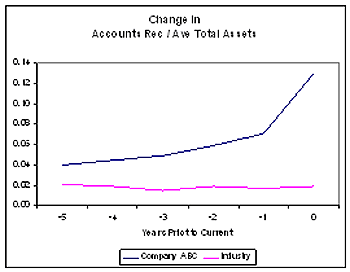By Tim Keefe ,CFA (Contact Author | Biography)
Not all accrual accounts are subject to the same management manipulation, and some accruals are worth more attention than others. Recall Figure 6 in Chapter 4. This table listed several accounting items, such as accounts receivable, inventory and PP&E, where management has a high degree of accounting flexibility. These accrual accounts are traditionally described as "operating" accruals because they are related to the daily production activities of the firm. Because management has a high degree of flexibility when using its accounting discretion for these types of accruals, they are characteristically prone to manipulation.
The fact that these operating accruals are used with high frequency to account for daily operating transactions as well as being prone to management's manipulation is only part of the reason to focus on them. In addition, operating accruals are typically shorter-term in nature, and therefore the consequences of manipulation (write-offs and restatements) will reveal themselves in the short term. It is therefore helpful to break down total net accruals into a more specific subset of accruals, such as a group of operating accruals, or even to look at a single operating accrual item to see if management is using aggressive accounting techniques.
Reversals and Adjustments
Remember, an accrual is created in order to account for timing differences between the transaction event and the transfer of cash. With the passage of time and the completion of the transaction, cash is exchanged and the appropriate accrual-reversing entries are made. If the estimations used in creating the accruals were erroneous, then adjustments (write-offs) are made along with accrual-reversing entries. (For related reading, see Common Clues Of Financial Statement Manipulation.)
The reason that the reversals in the accounts we are focusing on here happen quickly is that many of the accounts being measured are working-capital accounts and are short term in nature. For example, suppose that a receivable is due in 90 days. As the deadline arrives and passes and the account remains unpaid, the firm should recognize that the account is uncollectible and make the accounting adjustments. On the other hand, estimation errors and manipulation in non-current accrual accounts may take longer to reverse out because of the nature of accruals. For example, the depreciation schedule for a factory is based on an expected life of 20 years with a residual value of 10%. If the expected life estimate is correct, the actual residual value won't be known for 20 years, so the depreciation expense could be incorrect for 20 years before accounting adjustments are made. (For more insight, read Working Capital Works.)
Articulation
The concept of articulation deals with the interrelationships among the three financial statements - the income statement, the balance sheet and the statement of cash flow. Perfect articulation would mean that information from cash flow from operating, investing and financing activities reported by firms in their statement of cash flow would coincide with corresponding cash flow estimates from income statement (net income) and balance-sheet data (changes in assets and liabilities).
The fact is that the cash flow estimated from the changes in balance sheet data will not always correspond to the cash flow in the statement of cash flow. This discrepancy occurs because not all changes in the balance sheet accounts are reflected in the income statement, and these transactions are classified differently in the statement of cash flow. For example, when a firm divests a business, the accounts receivable, inventory, PP&E, etc. will be reduced on the balance sheet, but these reductions are not similarly classified in the cash flow from operations section of the statement of cash flow. As such, the changes in these accounts based on the beginning-to-ending period amounts on the balance sheet will be lower than the amounts on the statement of cash flow.
The biggest reasons for non-articulation are divestitures, acquisitions and foreign currency translations. When using the balance sheet approach, accruals at firms completing a divestiture during the period would be biased downward, accruals at firms completing acquisitions would be biased higher and, if the home currency falls/rises, then accruals will be biased higher/lower as a result.
An important methodology issue needs to be addressed when looking at individual or subgroups of accruals. Due to non-articulation issues, using the cash-flow statement to source the accounting data is the better method when examining specific operating accounts such as accounts receivable, inventory, accounts payable, etc. That said, in cases of non-articulation, the balance sheet is still usable and academic studies have shown that high (or low) accrual accounts calculated with the balance sheet still predict lower (or higher) future stock returns. The downside is that the balance sheet calculations will be biased and may be capturing something along with or other than just accruals. (For more insight, read Testing Balance Sheet Strength.)
Net Operating Accruals
By isolating net operating accruals, the analyst gets insight into the amount of near-term accruals that are a result of operating activities. Extreme high or low accruals relative to peers are good indications that management has used overly aggressive/overly conservative accounting and that sometime in the near future, this will be reflected in reduced/improved operating performance.
This metric is calculated with the data from the statement of cash flow, and will be used in analysis just like the total net accrual metric.
Calculating Net Operating Accruals
Just like with total net accruals, this metric by itself is not very helpful because this value is not comparable to other firms' net operating accruals or with past net operating accruals of the same firm; we need something to compare this number to.
Scaling Accruals
Before comparing accrual amounts of one firm over time or with those of other firms, the accrual metric should be scaled by some factor like total assets in order to account for the fact that larger firms will naturally have larger amounts of accruals. You can typically get this job done by dividing the accrual amounts, whether it is the total net accrual or net operating accrual measurement, by average total assets.
Or
Firm's Life Cycle
As with total net accruals, the analyst can use the firm's life-cycle score to bring another dimension of understanding to firms with extreme net operating accrual amounts. The information resulting from the life-cycle classification can be used as a tool in quantitative models or just be kept in mind as the analyst interprets the results of any accrual or non-accrual analysis.
Analyzing Specific Operating Accruals
Further insight as to whether earnings quality is low can be gained by examining the growth pattern of operating accruals. The specific accruals to focus on are accounts receivable and inventory. In high-accrual firms, these operating accrual accounts, on average, appear to have patterns that may signal earnings management. These patterns are displayed in the graphs below. Time zero on the x axis indicates the most recent period. This is the time period where the accrual misestimation/manipulation catches up to management.
1. Accounts Receivable / Average Total Assets
2. Inventory / Average Total Assets
Typically, the accrual account experiences a slow buildup over several years and then a large jump, which marks the peak of the accrual misestimation/manipulation phase; a reversal of fortunes visits the firm over the next year. The slow buildup is not abnormal, but the large jump is suspect because accruals are fundamentally mean reverting. For example, as macroeconomic conditions slow down, accounts receivable may rise temporarily as customers take more time to pay. Eventually, they pay their past-due bills and the accounts receivable accrual comes back to normal levels.
On the other hand, a large jump is unusual and indicates that either there has been a large pick-up in growth at the firm or that there will be accounting adjustments regarding the impairment of these assets, as management has used aggressive accounting to achieve the current exceptional operating results. To get a bead on whether the upward spike is a negative event, look to see if there are write-downs at the firm's competitors and if business has soured at the firm's major customers.
Earnings Quality: Investigating The Financing Of Accruals
Not all accrual accounts are subject to the same management manipulation, and some accruals are worth more attention than others. Recall Figure 6 in Chapter 4. This table listed several accounting items, such as accounts receivable, inventory and PP&E, where management has a high degree of accounting flexibility. These accrual accounts are traditionally described as "operating" accruals because they are related to the daily production activities of the firm. Because management has a high degree of flexibility when using its accounting discretion for these types of accruals, they are characteristically prone to manipulation.
The fact that these operating accruals are used with high frequency to account for daily operating transactions as well as being prone to management's manipulation is only part of the reason to focus on them. In addition, operating accruals are typically shorter-term in nature, and therefore the consequences of manipulation (write-offs and restatements) will reveal themselves in the short term. It is therefore helpful to break down total net accruals into a more specific subset of accruals, such as a group of operating accruals, or even to look at a single operating accrual item to see if management is using aggressive accounting techniques.
Reversals and Adjustments
Remember, an accrual is created in order to account for timing differences between the transaction event and the transfer of cash. With the passage of time and the completion of the transaction, cash is exchanged and the appropriate accrual-reversing entries are made. If the estimations used in creating the accruals were erroneous, then adjustments (write-offs) are made along with accrual-reversing entries. (For related reading, see Common Clues Of Financial Statement Manipulation.)
The reason that the reversals in the accounts we are focusing on here happen quickly is that many of the accounts being measured are working-capital accounts and are short term in nature. For example, suppose that a receivable is due in 90 days. As the deadline arrives and passes and the account remains unpaid, the firm should recognize that the account is uncollectible and make the accounting adjustments. On the other hand, estimation errors and manipulation in non-current accrual accounts may take longer to reverse out because of the nature of accruals. For example, the depreciation schedule for a factory is based on an expected life of 20 years with a residual value of 10%. If the expected life estimate is correct, the actual residual value won't be known for 20 years, so the depreciation expense could be incorrect for 20 years before accounting adjustments are made. (For more insight, read Working Capital Works.)
Articulation
The concept of articulation deals with the interrelationships among the three financial statements - the income statement, the balance sheet and the statement of cash flow. Perfect articulation would mean that information from cash flow from operating, investing and financing activities reported by firms in their statement of cash flow would coincide with corresponding cash flow estimates from income statement (net income) and balance-sheet data (changes in assets and liabilities).
The fact is that the cash flow estimated from the changes in balance sheet data will not always correspond to the cash flow in the statement of cash flow. This discrepancy occurs because not all changes in the balance sheet accounts are reflected in the income statement, and these transactions are classified differently in the statement of cash flow. For example, when a firm divests a business, the accounts receivable, inventory, PP&E, etc. will be reduced on the balance sheet, but these reductions are not similarly classified in the cash flow from operations section of the statement of cash flow. As such, the changes in these accounts based on the beginning-to-ending period amounts on the balance sheet will be lower than the amounts on the statement of cash flow.
The biggest reasons for non-articulation are divestitures, acquisitions and foreign currency translations. When using the balance sheet approach, accruals at firms completing a divestiture during the period would be biased downward, accruals at firms completing acquisitions would be biased higher and, if the home currency falls/rises, then accruals will be biased higher/lower as a result.
An important methodology issue needs to be addressed when looking at individual or subgroups of accruals. Due to non-articulation issues, using the cash-flow statement to source the accounting data is the better method when examining specific operating accounts such as accounts receivable, inventory, accounts payable, etc. That said, in cases of non-articulation, the balance sheet is still usable and academic studies have shown that high (or low) accrual accounts calculated with the balance sheet still predict lower (or higher) future stock returns. The downside is that the balance sheet calculations will be biased and may be capturing something along with or other than just accruals. (For more insight, read Testing Balance Sheet Strength.)
Net Operating Accruals
By isolating net operating accruals, the analyst gets insight into the amount of near-term accruals that are a result of operating activities. Extreme high or low accruals relative to peers are good indications that management has used overly aggressive/overly conservative accounting and that sometime in the near future, this will be reflected in reduced/improved operating performance.
This metric is calculated with the data from the statement of cash flow, and will be used in analysis just like the total net accrual metric.
Calculating Net Operating Accruals
Net Operating Accruals = Accrual Earnings - Cash Flow from Operations = Net Income - Cash Flow from Operations |
Just like with total net accruals, this metric by itself is not very helpful because this value is not comparable to other firms' net operating accruals or with past net operating accruals of the same firm; we need something to compare this number to.
Scaling Accruals
Before comparing accrual amounts of one firm over time or with those of other firms, the accrual metric should be scaled by some factor like total assets in order to account for the fact that larger firms will naturally have larger amounts of accruals. You can typically get this job done by dividing the accrual amounts, whether it is the total net accrual or net operating accrual measurement, by average total assets.
Total Net Accruals /[(Total AssetsPeriod 0 + Total AssetsPeriod 1)/2] |
Or
Net Operating Accruals / [(Total AssetsPeriod 0 + Total AssetsPeriod 1)/2] |
Firm's Life Cycle
As with total net accruals, the analyst can use the firm's life-cycle score to bring another dimension of understanding to firms with extreme net operating accrual amounts. The information resulting from the life-cycle classification can be used as a tool in quantitative models or just be kept in mind as the analyst interprets the results of any accrual or non-accrual analysis.
Analyzing Specific Operating Accruals
Further insight as to whether earnings quality is low can be gained by examining the growth pattern of operating accruals. The specific accruals to focus on are accounts receivable and inventory. In high-accrual firms, these operating accrual accounts, on average, appear to have patterns that may signal earnings management. These patterns are displayed in the graphs below. Time zero on the x axis indicates the most recent period. This is the time period where the accrual misestimation/manipulation catches up to management.
1. Accounts Receivable / Average Total Assets
 |
| Figure 12 |
| Source: "Earnings Quality and Stock Returns", The Journal of Business, May 2006 |
2. Inventory / Average Total Assets
 |
| Figure 13 |
| Source: "Earnings Quality and Stock Returns", The Journal of Business, May 2006 |
Typically, the accrual account experiences a slow buildup over several years and then a large jump, which marks the peak of the accrual misestimation/manipulation phase; a reversal of fortunes visits the firm over the next year. The slow buildup is not abnormal, but the large jump is suspect because accruals are fundamentally mean reverting. For example, as macroeconomic conditions slow down, accounts receivable may rise temporarily as customers take more time to pay. Eventually, they pay their past-due bills and the accounts receivable accrual comes back to normal levels.
On the other hand, a large jump is unusual and indicates that either there has been a large pick-up in growth at the firm or that there will be accounting adjustments regarding the impairment of these assets, as management has used aggressive accounting to achieve the current exceptional operating results. To get a bead on whether the upward spike is a negative event, look to see if there are write-downs at the firm's competitors and if business has soured at the firm's major customers.
Earnings Quality: Investigating The Financing Of Accruals
Related Articles
-
 Investing
InvestingHow To Decipher Accrual Accounting
Accrual accounting is an important method of measuring the performance and position of a company. Learn more on how its used. -
 Investing
InvestingCash Flow From Operating Activities
Cash flow from operating activities is a section of the Statement of Cash Flows that is included in a company’s financial statements after the balance sheet and income statements. -
 Investing
InvestingAnalyze cash flow the easy way
Learn the key components of the cash flow statement, how to analyze and interpret changes in cash, and what improved free cash flow means to shareholders. -
 Investing
InvestingCorporate Cash Flow: Understanding the Essentials
Tune out the accounting noise and see whether a company is generating the stuff it needs to sustain itself. Learn how to read the cash flow statement.



